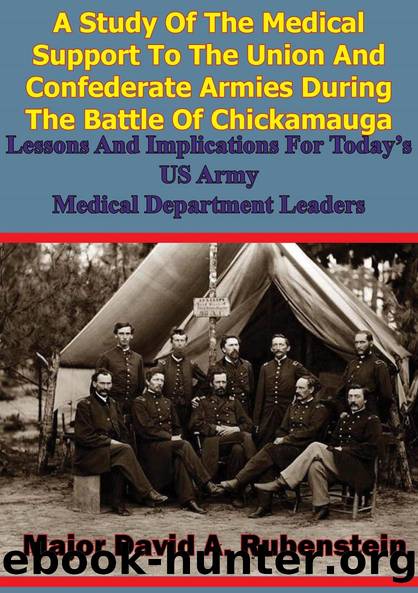A Study Of The Medical Support To The Union And Confederate Armies During The Battle Of Chickamauga: by Major David A. Rubenstein

Author:Major David A. Rubenstein [Rubenstein, Major David A.]
Language: eng
Format: epub
Tags: History, United States, Civil War Period (1850-1877), Military, Modern, 19th Century
ISBN: 9781782896357
Google: 0Y9vCwAAQBAJ
Publisher: Pickle Partners Publishing
Published: 2014-08-15T05:03:28+00:00
CONFEDERATE MEDICAL SUPPORT AT CHICKAMAUGA
Samuel Stoutâs loss of communications with Flewellen shortly before the Battle is symbolic of the problems inherent with studying medical support of the Southern forces for which little primary source material exists. As the battle opened for Braggâs Army, Flewellen was still suffering a shortage of medical officers. In denying a request for surgeons by a receiving and shipping hospital he explained that a âscarcity of Med. Officers in the field puts it out of my power to supply the demand.{193} As previously shown, Stout had detailed surgeons to report to the field. Not known is how many reported in time to provide support during the actual battle. The officers detailed from Newnan surely did not as they did not depart from that hospital until 19 September.{194}
The available regimental physicians performed the standard task of providing immediate aid at the front lines while brigade surgeons supported with additional care in hospitals to the rear. In fact, one of Flewellenâs surgeons is singled out for âgoing repeatedly far forward under fire and among the skirmishers to attend the wounded.â {195}
Ambulances were also used in the routine way. The Armyâs movement orders for 18 September allowed ambulances to follow the units as they crossed the Chickamauga.{196} They were then positioned behind the combat forces and loaded from that point. John Jackman, for instance, wrote of coming upon his brigadeâs ambulance to the rear.{197} Describing the vehicle as a brigade ambulance is significant as it supports the belief that they were in too short of supply to distribute down to the regimental level. Other accounts state that some regiments did not have individual ambulances while others, admittedly, had as many as two.{198}
The shortage of ambulances required that evacuation to the field hospitals be by any means possible. John Hood, in command of Longstreetâs Corps, was carried on a litter for the full distance to a field hospital. {199} In the Washington Artillery of Samuel Adamâs Brigade the wounded were carried on the limbers and caissons {200}. In many other cases, wounded soldiers simply limped, hopped, or dragged themselves off the field or were carried off by the less seriously injured. W.G. Allen, for example, suffering from six gunshot wounds, had his horse brought up and rode to the rear for aid. Elsewhere, B.J. Semmes watched as âa soldier wounded in the arms, [led] another to the rear with both eyes shot out. I often saw wounded soldiers carrying off a worse wounded companion.â {201}
From the front lines the wounded were carried, or found their own way, to field hospitals in the rear. For this particular battle both brigade and division hospitals were formed. The particular reason for choosing one method of establishment over the other is not reported, however. While most available buildings were probably used as medical facilities, determining specific hospital locations must be based on the casual remarks and reports of the participants to the battle. Some of the hospitals may have been near the lines, such as the field hospital of Henry Benningâs Brigade, Hoodâs Division.
Download
This site does not store any files on its server. We only index and link to content provided by other sites. Please contact the content providers to delete copyright contents if any and email us, we'll remove relevant links or contents immediately.
| United States | Abolition |
| Campaigns & Battlefields | Confederacy |
| Naval Operations | Regimental Histories |
| Women |
In Cold Blood by Truman Capote(3311)
The Innovators: How a Group of Hackers, Geniuses, and Geeks Created the Digital Revolution by Walter Isaacson(2849)
Steve Jobs by Walter Isaacson(2837)
All the President's Men by Carl Bernstein & Bob Woodward(2331)
Lonely Planet New York City by Lonely Planet(2173)
And the Band Played On by Randy Shilts(2131)
The Room Where It Happened by John Bolton;(2105)
The Poisoner's Handbook by Deborah Blum(2094)
The Murder of Marilyn Monroe by Jay Margolis(2059)
The Innovators by Walter Isaacson(2057)
Lincoln by David Herbert Donald(1949)
A Colony in a Nation by Chris Hayes(1881)
Under the Banner of Heaven: A Story of Violent Faith by Jon Krakauer(1750)
Amelia Earhart by Doris L. Rich(1650)
The Unsettlers by Mark Sundeen(1647)
Being George Washington by Beck Glenn(1628)
Birdmen by Lawrence Goldstone(1621)
Dirt by Bill Buford(1613)
Zeitoun by Dave Eggers(1594)
